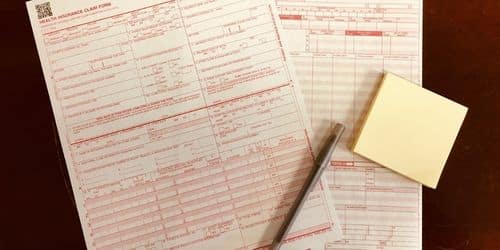As 92% of Americans have health insurance, medical billing is necessarily part of a practice’s routine activities. Admittedly, most practitioners didn’t get into medicine to file paperwork all day, but the HCFA form—the principal medical claim form—is rather easy to fill. This article will educate you all about the HCFA 1500 form, AFLAC, how to fill it out, and HCFA vs UB.
HCFA 1500 Form
The HCFA form, commonly known as Form HCFA 1500 or Form CMS-1500, is what non-institutional practitioners file to payers (insurance companies). They often comprise the basis of medical claims.
The abbreviation “HCFA” stands for “Health Care Finance Administration.” As you might assume from this moniker, the HCFA 1500 has official beginnings. It’s the work of the Centers for Medicare & Medicaid Services (CMS), which initially designed it to facilitate Medicare and Medicaid reimbursements.
Form HCFA is so detailed that private insurers have also adopted it as their norm.
How does the HCFA Form Work?
Practitioners like yourself (or, more realistically, your front-office staff or third-party medical billing team) will complete the HCFA form after a patient encounter. A complete HCFA form will include CPT codes for all services provided. The International Classification of Diseases, 10th Revision (ICD-10) codes for diagnosis may also be included. These codes standardize services, making it easier for payers to determine what to reimburse.
Your HCFA form should also include your patient’s demographics and basic information. Just as important, the form should clearly state your patient’s insurance information. Payers will know exactly which CPT and ICD-10 codes they may and cannot reimburse.
Who Fills out an HCFA Form?
Any of the following types of individual practitioners may complete and submit an HCFA form:
- Physicians
- Specialists
- Nurse practitioners
- Nurse-midwives
- Certified nurse anesthetic practitioners
- Physician assistants
- Clinical psychologists
- Clinical social workers
- Ambulance services
- Laboratory services
What information can be found on an HCFA form?
33 boxes make up the HCFA form. If that looks like a lot, don’t worry—each box takes very little information, much of which is rudimentary. In addition, we’ve produced the following billing instructions for HCFA so you can get through the procedure quickly. Each numbered entry in this guide corresponds to a box number on the HCFA form.
- Insurance information: Specify Medicaid, Medicare, or the patient’s private insurer in box 1a of the form.
- Patient’s entire legal name: Write the patient’s full legal name.
- Patient’s gender and birth date: Write the month, date, and year as two digits each. Select the proper box for the patient’s birth sex.
- Insured’s name: If the patient has their own insurance, leave this area blank. If their plan is in the name of someone else, write that person’s name here.
- The patient’s address and phone number: Put the required information in each box in this section of the form.
- Relationship between the patient and the insured: Tick the relevant box. You should only check one of the four boxes.
- Insured’s address: If the patient is self-insured, leave this area blank. If not, enter this information into the form for the person whose name is on the insurance policy.
- Patient status: Tick one item in the first row (marital status) and one box in the second row (employment status).
- Additional insurance information: If the patient only has the primary insurance listed previously on the form, leave this box blank. Provide all requested information in this form if the patient has supplementary insurance.
Read Also: What Is HSA? Everything You Need To Know
- Patient condition and Medicaid form: Indicate whether the services you gave were in response to injuries or illnesses incurred on the job, in an automobile accident, or in another type of accident. If the patient has Medicaid, enter it in the “reserved for local use” box.
- Policy or group number of the insured: Write down the patient’s policy, group, or FECA number below. You should also add the requested identifying information in the form. Check “yes” in box 11d if you added information to box 9.
- Patient signature: To submit any HCFA form, the patient must sign it. This is where you’ll put your signature.
- Insured’s signature: Only complete this part if the patient has supplementary insurance, as shown in box 9.
- Date of the ailment being treated: Record the day the patient first noticed symptoms.
- Prior reports of the condition being treated: If the patient encounters you’re billing for isn’t the patient’s first incident of this ailment, enter the initial date here instead. If this is the patient’s first time experiencing symptoms, you should specify the date of the encounter you’re paying for.
- Dates absent from work: Provide the days the patient has been absent from work due to their condition.
- Referral provider: Provide the name, ID number, and National Provider Identification of the practitioner that referred the patient to you (NPI).
- Hospitalization dates: If the patient’s condition necessitated hospitalization, list the dates below.
- Reserved for local use: If the form receiver needs it, leave this area blank.
- Outside lab charges: If you’re making a claim for third-party lab tests, check the “yes” box and write down the fee amount.
- CPT codes: List the CPT codes associated with the services delivered. You can use the page-width lines under “Diagnosis Pointer” to submit extra codes.
Read Also: Lively HSA Review: Investment Options and fees
- Medicaid resubmission code: Enter the original claim’s reference number here if you’re resubmitting a rejected Medicaid claim.
- Prior authorization number: Provide the authorization number if your patient brought prior authorization from the payer to their appointment. A seven-digit IDE number for investigational devices and a ZIP code for ambulance services are also required.
- Service details: Provide the service dates and location, the services delivered, and the related charge amounts. You’ll also finish the diagnosis pointer portion you saw in box 21.
- Tax identifier: Enter your employer identification number (EIN) or, if you are a lone practitioner without an EIN, your Social Security number.
- Patient account number: Though this box is optional, writing your patient’s account number inside your clinic will assist you to associate the claim with the patient and track progress accordingly.
- Accept assignment: Click the “yes” box for physician, laboratory, surgical, supplier, or ambulance services.
- Total charges: Enter the total amount of reimbursement requested.
- Amount paid: Enter the amount that has already been paid if applicable.
- Balance due: Subtract the value in box 29 from the value in box 28, then enter the result here.
- Provider Signature: Sign your HCFA form here.
- Service facility location information in the form: Provide the complete address of the location where services were rendered.
- Service Provider Information Form: Put your address again here, along with your NPI and phone number. Your HCFA form is now complete.
Claim Form HCFA 1500
Knowing the CMS-1500 definition ensures that physicians and healthcare workers use the CMS-1500 form to appropriately file medical claims. Form CMS-1500 is a paper claim form used by healthcare providers to bill Medicare carriers.
Most paper claims submitted to Medicare are read using Optical Character Recognition (OCR) technology, therefore you must complete the form in red ink. You should also double-check that you’ve filled every required section of the form before submitting it.
Before you File a Claim
Although paper claims are still accepted, physicians can submit the CMS-1500 form electronically. The payment will be determined by several aspects, including the patient’s condition, the client’s and the patient’s network status, and any previous settings.
Completing a CMS Claim Form
An HCFA-1500 claim form contains roughly 33 fields that collect information on the patient, professional, and treatment procedure. Each claim form must be properly filled in order for the payer to process the payments. As a result, healthcare practitioners should communicate with payers to understand billing methods.
Claims Made Electronically
To use electronic claims, both parties must agree on the billing method. Some payers will require prior third-party consent before processing claims. The transactions must adhere to EDI specifications. Distinctive electronic filing codes will reduce errors in the claims procedure.
HCFA 1500 Form AFLAC
The days of terrifyingly complex legal and tax forms are passed. The entire procedure of filling out official paperwork is stress-free using US Legal Forms. For filling out an Aflac Accident Injury Claim Form, the best editor is right around the corner, ready to provide you with a variety of useful tools. These instructions, along with the editor’s assistance, will guide you through the entire process.
- Select the Get Form option to begin enhancing.
- To gain more recommendations, activate the Wizard mode on the top toolbar.
- Fill out every available space.
- Ensure that the information you include on the Aflac Accident Injuries Claim Form is current and accurate.
- Use the Date option to add a date to the sample.
- Choose the Sign icon to generate a digital signature. Type, draw, or upload are the three options.
- Verify that each field is correctly filled out.
- Click Done in the upper right corner to save or send the record. There are numerous options for obtaining the document. As an instant download, an attachment in an email, or in the mail as a hard copy.
Each Aflac Accident Injuries Claim Form is easier to complete.
HCFA vs. UB
Individual, non-institutional practitioners file HCFA forms, whereas institutional practitioners submit Form UB -04. Hospitals, inpatient facilities, nursing homes, and other medical facilities use Form UB-04. Instead, Form HCFA is used by all other practitioners.
This line separating Form UB-04 from HCFA is admittedly hazy. Experts in medical billing, on the other hand, are perfectly aware of the distinction. Better yet, medical billing professionals at third-party medical billing companies (for example, read our AdvancedMD review) may prepare and file these papers on your behalf.
Visit the medical billing’s best picks page if you’d rather not deal with the hassle of selecting the appropriate papers and spending time on paperwork. There, you’ll find recommendations for third-party medical billing services depending on your practice size, specialty, billing complexity, and other variables. The medical billing procedure might be time-consuming, but with outsourced medical billing, it is greatly simplified.
How to File an HCFA form
After you’ve finished your form, run it through a claim scrubber to check for problems. These tools are typically provided by third-party medical billing service companies. After correcting the inaccuracies, resubmit your HCFA form to an appropriate clearinghouse, which will send it to the right payer.
Is HCFA the same as CMS-1500?
Yes. The HCFA 1500 claim form, also known as CMS-1500, allows medical doctors to file health insurance claims for reimbursement from government insurance plans such as Medicare, Medicaid, and Tricare.
What is an HCFA 1500?
It is the standard form mandated by HCFA for Medicare claims from physicians and suppliers except for ambulance services.
How do you fill out an HCFA 1500?
After you’ve finished your form, run it through a claim scrubber to check for problems. These tools are typically provided by third-party medical billing service companies. After correcting the inaccuracies, resubmit your HCFA form to an appropriate clearinghouse, which will send it to the right payer.
When was HCFA used?
The HCFA -1500 form (CMS-1500) is used to submit Medicare Part B charges.
What is the HCFA billing type?
Non-institutional practitioners bill insurance companies for services rendered using the HCFA form.
Who fills out HCFA 1500 form?
The HCFA-1500 (CMS 1500) is a medical claim form used by individual doctors and practices, nurses, and professionals, such as therapists, chiropractors, and outpatient clinics.
Related Articles
- Best Health Insurance For Unemployed In 2023
- Finance Documentaries: Best 10 Listing for Newbies & Pros (Updated)
- WHAT IS MEDICAL CODING: What Is It, Examples, Types & What They Do
- Best Top 13 BILLING SYSTEMS FOR SMALL BUSINESS in 2023 (Updated)
- PAIN MANAGEMENT TOOLS: Guide to Chronic Pain Management & Assessment Tools






